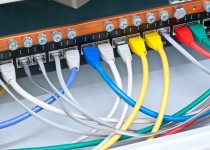
Schools across the country are finding that investing in energy-efficient technology has an economic benefit as well as helping to save the environment.
“We’re estimating saving about $30,000 per year, and that’s [mainly] by consolidating servers,” said Paul Romero, executive director of technology at Rio Rancho Public Schools in New Mexico.
CDW Government LLC (CDW-G) surveyed 756 technology professionals for its 2010 “Energy Efficient IT Report” and found that three-quarters of respondents are working to reduce energy use in their IT operations. If current energy use rates don’t change, greenhouse gas emissions from data centers will outweigh those from the airline industry by 2020, the company warns.
“The power usage in the data center is ever increasing, especially with rising energy costs,” said Mark Lafferty, director of strategic solutions and services for CDW-G. “That seems to be the most popular place to review your energy strategies.”
The ability to bring down costs while improving efficiency and helping to save the environment inspired Romero to pursue energy-use changes in his ed-tech department.
“We looked at it as a good project that could do both very effectively and efficiently,” said Romero.
Romero said that the heat generated by a large number of ed-tech systems cause schools to waste money on air conditioning as well.
“We’re going to really look at energy efficiency as far as projectors [go]. Instead of getting a regular bulb that creates a lot of heat, we’re looking at LED lights so we don’t have to cool the classroom,” said Romero. Romero’s goal is to continue to reduce his district’s servers down to a point where every twenty servers can be replaced by a single unit.
“There’s been a lot of over-capacity for a long time,” added Lafferty. “I think with the onset of virtualization, you’re getting more efficiency through fewer servers. With the consolidation there, you gain the benefit of not needing to cool and to power as many servers.”
Lafferty encouraged other schools to map out their own ed-tech energy use.
“Utilize some of the tools that are available, either from the EPA or the Department of Energy, to really get a take on what you have and what your energy consumption looks like,” he said. “[Then] build a strategy to address those needs.”
CDW-G suggested the following strategies to cut back on energy use in ed-tech departments:
• Deploying more power-efficient core switches;
• Replacing edge and workgroup switches with more power-efficient switches;
• Using the network as a platform to manage and reduce energy use;
• Adopting 10GB Ethernet, Infiniband technologies;
• Reducing storage area network infrastructure by implementing Fiber-channel Over Ethernet (FcOE); and
• Moving to top-of-rack models for access layer switching.
CDW-G found that of those organizations already actively trying to manage their energy use, 56 percent have reduced their annual annual IT energy costs by at least 1 percent.
Data centers currently account for 1.5 percent of the total U.S. energy consumption, which accounts for $4.5 billion a year, according to federal figures. The Environmental Protection Agency has predicted that that amount will nearly double within the next five years.
- New film fights negative perception of teachers - September 16, 2011
- Textbook-free schools share experiences, insights - September 7, 2011
- Social websites are latest sources for plagiarized material - September 1, 2011


Comments are closed.